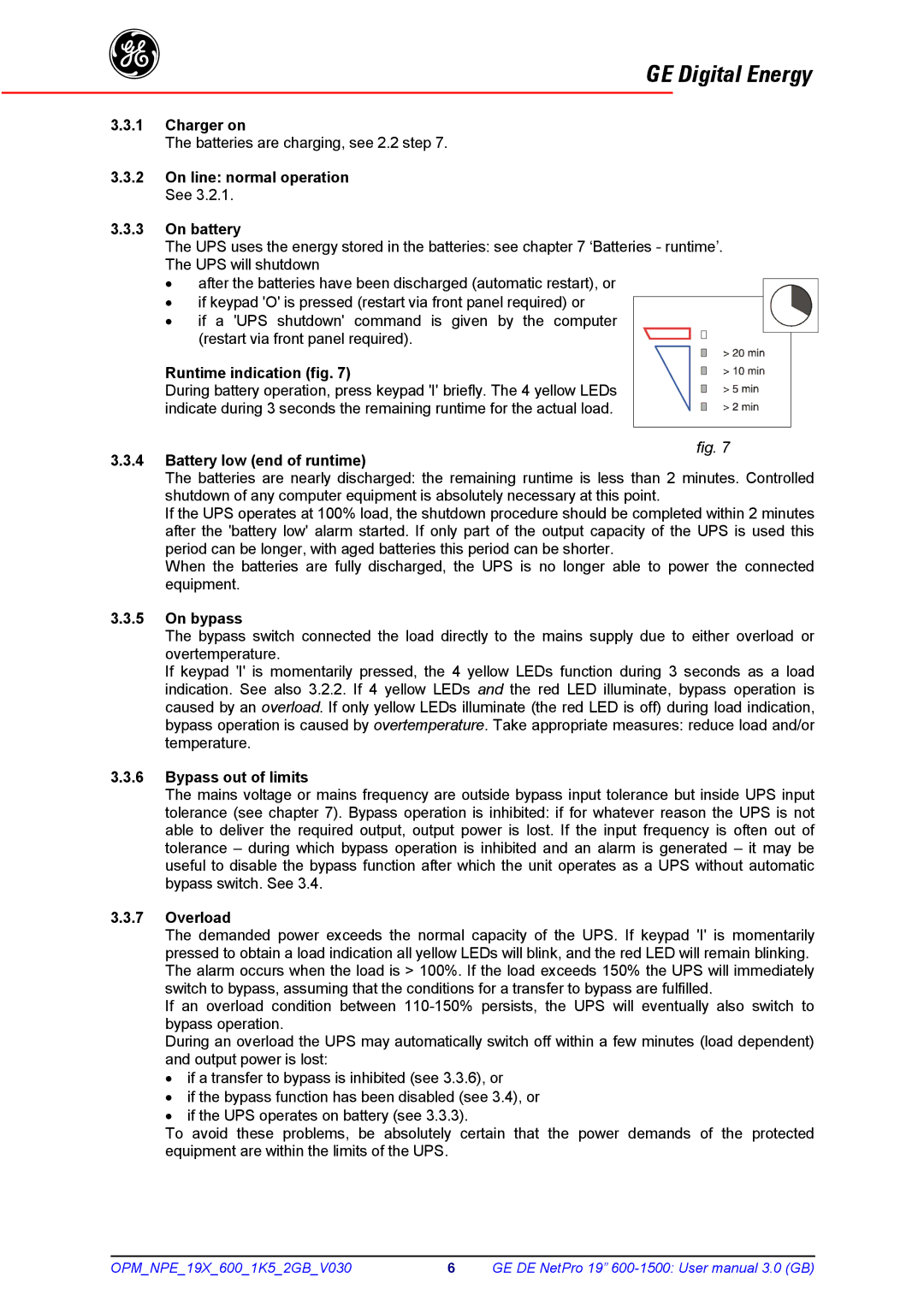
g
GE Digital Energy
3.3.1Charger on
The batteries are charging, see 2.2 step 7.
3.3.2On line: normal operation See 3.2.1.
3.3.3On battery
The UPS uses the energy stored in the batteries: see chapter 7 ‘Batteries - runtime’. The UPS will shutdown
ξafter the batteries have been discharged (automatic restart), or
ξif keypad 'O' is pressed (restart via front panel required) or
ξif a 'UPS shutdown' command is given by the computer
(restart via front panel required).
Runtime indication (fig. 7)
During battery operation, press keypad 'I' briefly. The 4 yellow LEDs indicate during 3 seconds the remaining runtime for the actual load.
3.3.4 Battery low (end of runtime)
The batteries are nearly discharged: the remaining runtime is less than 2 minutes. Controlled shutdown of any computer equipment is absolutely necessary at this point.
If the UPS operates at 100% load, the shutdown procedure should be completed within 2 minutes after the 'battery low' alarm started. If only part of the output capacity of the UPS is used this period can be longer, with aged batteries this period can be shorter.
When the batteries are fully discharged, the UPS is no longer able to power the connected equipment.
3.3.5 On bypass
The bypass switch connected the load directly to the mains supply due to either overload or overtemperature.
If keypad 'I' is momentarily pressed, the 4 yellow LEDs function during 3 seconds as a load indication. See also 3.2.2. If 4 yellow LEDs and the red LED illuminate, bypass operation is caused by an overload. If only yellow LEDs illuminate (the red LED is off) during load indication, bypass operation is caused by overtemperature. Take appropriate measures: reduce load and/or temperature.
3.3.6 Bypass out of limits
The mains voltage or mains frequency are outside bypass input tolerance but inside UPS input tolerance (see chapter 7). Bypass operation is inhibited: if for whatever reason the UPS is not able to deliver the required output, output power is lost. If the input frequency is often out of tolerance – during which bypass operation is inhibited and an alarm is generated – it may be useful to disable the bypass function after which the unit operates as a UPS without automatic bypass switch. See 3.4.
3.3.7 Overload
The demanded power exceeds the normal capacity of the UPS. If keypad 'I' is momentarily pressed to obtain a load indication all yellow LEDs will blink, and the red LED will remain blinking. The alarm occurs when the load is > 100%. If the load exceeds 150% the UPS will immediately switch to bypass, assuming that the conditions for a transfer to bypass are fulfilled.
If an overload condition between
During an overload the UPS may automatically switch off within a few minutes (load dependent) and output power is lost:
ξ if a transfer to bypass is inhibited (see 3.3.6), or
ξ if the bypass function has been disabled (see 3.4), or ξ if the UPS operates on battery (see 3.3.3).
To avoid these problems, be absolutely certain that the power demands of the protected equipment are within the limits of the UPS.
OPM_NPE_19X_600_1K5_2GB_V030 | 6 | GE DE NetPro 19” |
